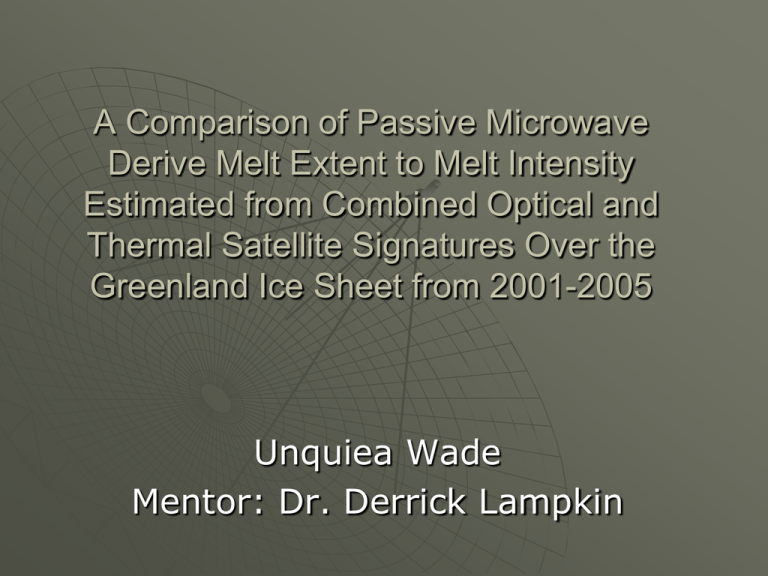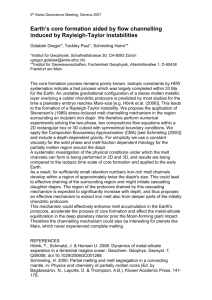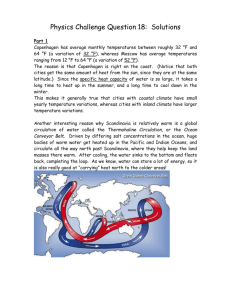PowerPoint
advertisement

A Comparison of Passive Microwave Derive Melt Extent to Melt Intensity Estimated from Combined Optical and Thermal Satellite Signatures Over the Greenland Ice Sheet from 2001-2005 Unquiea Wade Mentor: Dr. Derrick Lampkin The Center for Remote Sensing of Ice Sheets The Center for Remote Sensing of Ice Sheets (CReSIS) is a Science and Technology Center established by the National Science Foundation (NSF) in 2005 • • The mission of CReSIS is to develop new technologies and computer models to measure and predict the response of sea level change to the mass balance of ice sheets in Greenland and Antarctica. • NSF’s Science and Technology Center (STC) program combines the efforts of scientists and engineers to respond to problems of global significance, supporting the intense, sustained, collaborative work that is required to achieve progress in these areas. The earth is a system Which is effected by processes that occur Responds to these processes and changes These changes are then study and monitored Data Special Sensor Microwave/ Imager brightness temperature grids were downloaded from National Snow and Ice Data Center. (NDIDC) SSMI files were collected for three different channels Satellite Ascending/Descending: 19H.GHZ,37V .GHZ, /37V.GHZ Brightness Temperature This distinct change is observed in the brightness temperature (Tb) signal according to the Rayleigh Jeans approximation: TB ( ) TP where Tb refers to the microwave brightness temperature at a particular wavelength (λ or frequency υ), ε is the microwave emissivity, and Tp is the effective physical temperature of the snow (Zwally, 1977) Melt Occurrence and Extent Retrival Techniques Technique 1:Cross Polarization Gradient Ratio (XPGR ) [Abdalati and Steffen [1995, 1997] TB (19 H ) TB (37V ) XPGR TB (19 H ) TB (37V ) Technique 2: Dirnual Ampltiude Variation (DAV) [Ramage and Isacks [2002] DAV abs(TB (37V )ascending - TB (37V )descending ) B TB A XPGR Derived Melt Occurrence (Day 161 , Year 2000) Blue: Melt Occurrence White: No Melt Occurrence DAV Derived Melt Occurrence (Day 161 , Year 2000) Blue: Melt Occurrence White: No Melt Occurrence Melt Magnitude Retrieval Liquid Water Fraction Results 2001 Melt Occurrence vs Melt Magnitude for Composite Period 193 XPGR and DAV AVERAGE EMELT 2002 Melt Occurrence vs Melt Magnitude for Composite Period 193 0.25 0.25 0.2 0.2 0.15 DAV and XPGR Average EMELT 0.1 XPGR AVG EMELT DAV AVG EMELT 0.05 0 1 2 3 4 5 6 7 8 9 0.15 0.1 XPGR AVG EMELT DAV AVG EMELT 0.05 0 1 2 3 4 5 6 7 8 9 XPGR AVG EMELT 0.05 0.13 0.13 0.14 0.14 0.14 0.13 0.13 0.12 XPGR AVG EMELT 0.05 0.08 0.1 0.11 0.11 0.1 0.11 0.14 0.15 DAV AVG EMELT 0.01 0.02 0.02 0.02 0.03 0.05 0.08 0.1 0.11 DAV AVG EMELT 0.02 0.02 0.02 0.02 0.03 0.04 0.07 0.09 0.1 XPGR and DAV DAILY COUNTS DAV and XPGR Daily Counts Results Contd.. 2003 Melt Occurrence vs Melt Magnitude for Composite Period 193 0.3 0.3 0.25 0.25 0.2 0.2 DAV and XPGR 0.15 AVG EMELT DAV and XPGR 0.15 EMELT XPGR AVG EMELT 0.1 DAV AVG EMELT 0.05 0 1 2 3 4 5 6 7 8 9 0 0.01 0.02 0.03 0.03 0.04 0.07 0.1 0.12 DAV and XPGR DAILY COUNT XPGR AVG EMELT 0.1 DAV AVG EMELT 0.05 0 XPGR AVG EMELT 0.05 0.12 0.13 0.13 0.14 0.14 0.14 0.15 0.15 DAV AVG EMELT 2004 Melt Occurrence vs Melt Magnitude for Composite Period 193 1 2 3 4 5 6 7 8 9 XPGR AVG EMELT 0.08 0.12 0.12 0.13 0.13 0.14 0.14 0.13 0.13 DAV AVG EMELT 0.05 0.07 0.06 0.06 0.07 0.09 0.1 0.12 0.12 DAV and XPGR DAILY COUNTS Results Contd… 2005 Melt Occurrence vs. Melt Magnitude for Composite Period 193 0.25 0.2 DAV and XPGR EMELT 0.15 0.1 XPGR AVG EMELT DAV AVG EMELT 0.05 0 1 2 3 4 5 6 7 8 9 XPGR AVG EMELT 0.05 0.1 0.13 0.13 0.13 0.13 0.14 0.13 0.12 DAV AVG EMELT 0.02 0.02 0.02 0.03 0.03 0.06 0.09 0.1 0.11 DAV and XPGR DAILY COUNTS Conclusions Results indicate that DAV show a much more proportional relationship to melt magnitude than XPGR consistently during the analysis period. Both techniques show a scaled increase in melt occurrence with melt magnitude from the early part of the melt season (Day 145- May 25) than later in the melt season (Day 193-July 12). Difference in the comparison of XPGR and DAV to E-melt may be due to the ability of DAV to track more night time persistent melt, producing higher occurrences of melt. Emelt values derived from surface reflectance and temperature may be sensitive the diurnal effects as well resulting in a stronger relationship to DAV than XPGR. Further work is necessary to explain these trends. Questions Acknowledgements Center for Remote Sensing of Ice Sheets Center of Excellence in Remote Sensing Education and Research College of Earth and Mineral Sciences Peter Burkett Dr. Derrick Lampkin Dr. Linda Hayden






